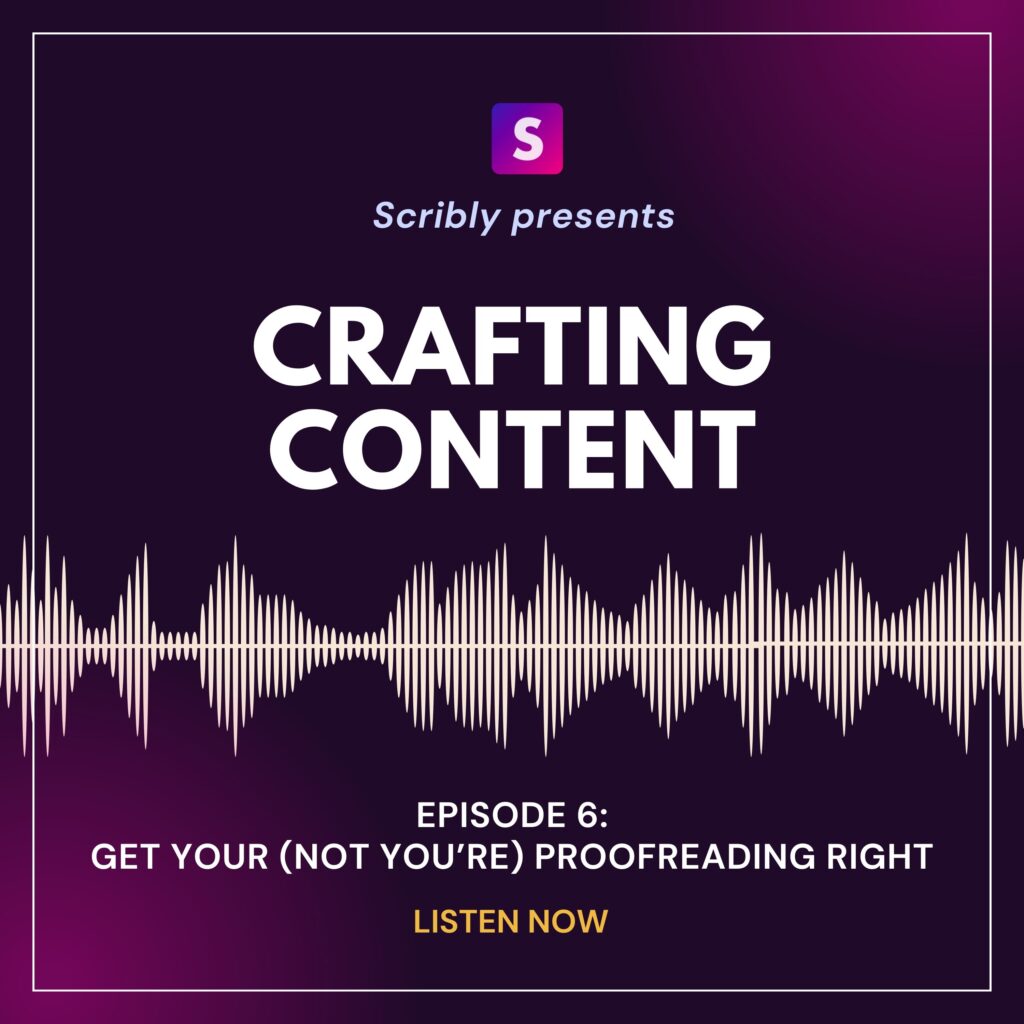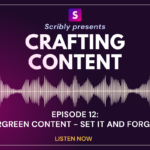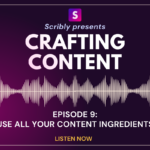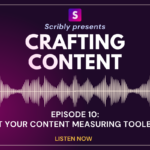Crafting Content – A content marketing podcast from Scribly
Crafting Content Episode 6: Get your (not you’re) proofreading right
The sixth episode of Scribly’s “Crafting Content” podcast is here! In this content marketing podcast, we share insights, top tips, and real-world examples to help you develop your content marketing skills.
Continuing on our “common content marketing mistakes” mini-series, today’s topic is proofreading. We discuss the importance of checking your content for consistent tone of voice and brand messaging, as well as typos, grammatical errors, flow disruptions, and more. Plus, we share our top tips to help you speed up the process and discuss helpful tools, extensions, and apps that can make the process even smoother.

You can listen to the full episode here: Scribly’s Content Marketing Podcast Episode 6: Get your (not you’re) proofreading right
Episode 6: Get your (not you’re) proofreading right (transcript)
Taylor: Hello and welcome to another episode of Crafting Content, the Scribly podcast, where we talk about all things content marketing. Today we are continuing our little series about common content marketing mistakes that we see. Joining me today are my coworkers, Elle Scribly’s Head of Content.
Elle: Thanks for having me on the show again.
Taylor: And Alex, Content Writer and Account Manager here at Scribly.
Alex: Hi, Taylor.
Taylor: Today, the mistake that we’re going to talk about is forgetting or failing to proofread.
Elle: So I think, Taylor, you might actually be the best speaker for this one, given that you edit, what 50,000 words a month?
Taylor: That’s my general average, yeah.Tthis is a cause near and dear to my heart, because at the end of the day, the goal of good content is immersion. You want people to be pulled in, you want them to stay put, and read what you have to say. Or, if the content is not written, to sit down, watch, and be captivated. And, while we’re talking about written content, maybe it’s just me, because I have the sort of editing curse of everything that I read, I mentally edit, which makes reading at night really frustrating sometimes. There’s nothing that pulls me out of something that I’m reading like a typo. I don’t know. Are you guys the same?
Elle: 100%. I was at a restaurant a couple of weeks ago and I was just going through their menu, reading out all the typos. They were like: “leave the work at home”.
Taylor: Just enjoy the food. Yeah, I read, very, mid tier detective novels that are cheap on Amazon at night and I spend most of my brain power re-editing them in my mind.
Elle: So you’ve talked about how forgetting to proofread pulls out the reader because it interrupts their flow when they suddenly notice that there’s a mistake online. I think that always makes me think of Internet trolls who lose an argument because their grammar is really poor. I think it’s that idea that people judge you based on the quality of your work, and often that comes down to proofreading. What’s your experience of that?
Taylor: I think that’s true. And I don’t know, I kind of think about content in a way as like, it’s part of your company’s resume or it’s part of a job interview almost. You’re trying to present yourself to your customers or colleagues in your industry and you want to come across as professional as possible. Obviously, depending on your budget, that’s going to look different for every company. But one of the quickest and simplest things you can do is to make sure that everything that you put out there is as error free as possible. Yeah.
Elle: It’s a good impression that you make on your business. Yeah, absolutely.
Taylor: Yeah.
Elle: We get, obviously, quite a lot of writer applications through at Scribly and the number of people who apply to be a writer who send me a CV or a message or something with a typo in it… It’s just an automatic ‘No’ from me because 1) you’re going to be a nightmare to edit, and 2) you just don’t have that eye for detail. I think it’s so important because it’s the first impression that you make on a customer or your target audience.
Taylor: Yeah. And I also should say that I make so many typos when I write. My writing is a mess. So if I can make a living editing stuff, so can you. It’s not that hard and we’ll talk in a couple of minutes about some tricks that we use, and things to look out for. But, I think sometimes if you’re not a writer, it can feel a little bit daunting to look at a whole chunk of content, a blog post or an ebook, and be like, well, now I have to make sure this has no mistakes at all. But it doesn’t have to be super complicated.
Elle: Building on that, if someone was to ask you some core tips that they should use when editing anything from a small social media caption all the way through to, as you say, a really large ebook, what’s your number one tip? Or where should they start?
Taylor: So I think that the first thing you should do is less copy editing and more big picture tone editing, looking to make sure that whatever you’re putting out there really aligns with your brand and the tone of voice and style that you’ve set up already. And, again, that doesn’t have to be super complicated. It could just be like, we have an approachable, friendly tone that still presents our company as knowledgeable. That’s kind of a general one that we see a lot. Right. So, you want to just make sure that if your tone is conversational, you’re not using really flowery, complex language in your Facebook posts or your blog posts or any of that. So that’s the first step. And if that passes that check, then you want to narrow down the funnel of detail and say, okay, so the tone matches. Great. Then you want to think about formatting. Like, are you presenting this in a way that is going to be engaging or at least not intimidating to readers? Is there enough white space? Are things spaced out enough? Do you have different kinds of writing? So, bullet point lists and maybe a quote or plenty of subheadings to break up any complex topics, that sort of thing. So, once you get those big picture things out of the way, then it’s time to get into the weeds a bit and look at what’s been written in detail. Look for common grammar mistakes, commonly misused words. Things like ‘they’re’ and ‘their’, which is one that I make fairly often. And it’s not necessarily because you don’t know it, it’s just because your brain writes it and you don’t pay attention.
Elle: Yeah, I guess it’s just in the moment and in the flow. Do you have a biggest pet peeve in terms of typos?
Taylor: I really struggle with ‘accept’ and ‘except’, or ‘affect’ and ‘effect’. Yeah, I think the ones that I get most annoyed by are the ones that I’ve spent the most time learning how to do correctly in my life. But, yeah, it’s those kinds of things that, it’s really tough because we learn most of these things from spoken English. And unless you’ve spent a considerable amount of time studying the homonyms and all this sort of stuff, then you don’t necessarily know which one to use. I also constantly mistype ‘its’ and it’s because my brain decides everything needs an apostrophe.
Elle: I think that’s probably one of the ones that we edit the most.
Alex: Definitely.
Elle: I still use that trick of reading out the sentence and going, it is. Oh, yeah, that fits. Okay, it’s apostrophe. Probably what you’re taught as a six year old, but sometimes what you learn at school works best.
Taylor: Yeah, exactly. It’s little things like that as well that can really help if you’re proofreading something like reading sentences or the whole thing out loud can really help you find not just mistakes, but also spots where things kind of stick. They don’t sound quite right. And, generally here at Scribly, we say if it doesn’t sound right when you read it out loud, then it should probably be written a little bit differently, a little more simply.
Elle: Yeah, that’s definitely a great tip because, if you read it out loud, sometimes you notice that a sentence is maybe grammatically correct, but just too long. So, if you start to get a bit breathless reading it, that tells you ‘Right, I probably need a full stop to tear this into two sentences, or some sort of comma, or m dash, or something in there to make it more readable.
Taylor: Yeah, exactly.
Elle: So you said you’ve relied on, jokingly, some things that we learned in school, but then also reading it out loud. Have you got any other tools, apps, or extensions that you find quite useful when it comes to editing?
Taylor: So, fun fact about me is that in high school, I failed my grammar proficiency test three times my junior year. Who would have thought? Hi, do I still have a job at the end of this podcast? Who knows? So, I suck at technical grammar. I’ve picked it up over the year, but it’s not ingrained. I just edit based on what sounds right. So, to pick up on the things that are technically incorrect, I use Grammarly, which is an online tool. They also have desktop, I think, and mobile apps now, and it just checks your work as you go along. You can use it in Google Docs as an extension. You can type directly into it, online or in the desktop app, and it just comes along behind you and is like ‘hey, this sentence doesn’t really make sense. Here’s how to make it a little bit better, a little bit easier to read’. And what’s cool about Grammarly as well is that you can set—to a certain degree—what kind of tone you want it to go for and what kind of audience that you’re looking to reach, if they’re expert and super knowledgeable, or if they’re just a general audience, that sort of thing as well. I highly recommend that.
Elle: And it’s quite a useful tool to make things homogeneous so that it’s consistent across all branding. We’ve got a few clients here at Scribly that are really large accounts and it’s often too much for one person to manage. So we’re kind of splitting them between two or three people. So I guess that tool can help us maintain consistency between editors. But I always think one of the interesting things when you edit is there is always a touch of personality in there. So you’ll pick up on—and I think you have the advantage of being american for this—is the use of passive voice.
Taylor: Yeah.
Elle: Whereas I think British English tends to lean on that a little bit more. So Alex and I are less likely to pick up on that. So, I always find there’s also the danger of proofreading to death where you could consistently kind of edit. And I think maybe Alex, because as a writer, your experience of reading and proofreading your own work and wanting to constantly kind of rewrite it, I guess it’s kind of finding that balance as well.
Alex: Yeah, I think so. You can get into a point where you just are working on the same thing over and over and over again and at some point it’s got to be done. But especially with your own work, it’s hard to find that point and say, yeah, no, I’m done with this now.
Elle: Yeah. So I guess the key question is, when do you stop? What level do you reach where you look at a piece as an editor and go, yeah, this is good enough.
Taylor: Now, I think you just kind of get a feel for it over time, like after a couple passes. You also have to remember that hopefully your readers are human, so they also understand that you too are human. And if there’s a typo or a comma splice, one thing, most people won’t know what that is and don’t care if they do know. And the other thing is, it’s not a big deal. A few mistakes here and there, it’s fine. So I think you get it to the point where when you’re reading it through, it looks good to you. Nothing really jumps out as, like, this looks wrong or this sounds not quite the way I want it to sound. And once you get it to that point, then maybe you send it to a coworker or you work with an editor or a writer who can help you go through things and just have a fresh set of eyes, because that happens a lot here on the Scribly team. Like, one of us will write something and we are too close to it. We need someone else to sort of take a look and say ‘oh, this sounds kind of funny’ or ‘let’s restructure these two sections’ or something like that.
Elle: Yeah. That’s a really good tip that you’re coming to, which is if you’re proofreading your own work, or even if you’re double checking something you’ve already proofread, maybe leave it for a day or two if time allows. So you’ve got that distance and that fresh pair of eyes, and if you can’t do that, then, yeah, lean on someone else to be that second pair so that it’s always a new opinion, as opposed to your brain filling in sentences with missing things, which you then become a little bit blind to. So it’s a great way of avoiding that.
Taylor: Yeah, definitely. I think distance and time can be really helpful tools. Yeah.
Alex: One thing I found that’s quite good if you don’t have the distance or the time, necessarily, is changing the font of whatever you’re reading, because that can. I mean, it doesn’t always work, but it can help you to almost look at it with a set of fresh eyes. Because I think when you’re reading the same thing over and over again, there will definitely be certain sections or sentences that you’ll kind of just gloss over and you don’t really read. And then just something as simple as changing the font, it gives you a fresh perspective on it. So I found that to be helpful sometimes.
Elle: Yeah, that’s a really good idea because I guess where the words fall on the page influences kind of the flow of it. So you might notice ‘oh, actually, we need a comma here’. Yeah, that’s a great tip.
Taylor: I’m going to try that. Put everything that I edit in comic sans.
Alex: Comic sans.
Taylor: Obviously, there’s no other option. Yeah, I hadn’t heard that. That’s really cool. Yeah. So I think do the best you can, try to make things as typo free and as grammatically correct as possible. Lean on tools and friends and coworkers as needed. But, yeah, definitely do proofread because the more you can present a consistent—tying into our last episode—feel for your content across all of your communications with your customers, the better people will perceive your brand and your company. Brilliant.
Elle: Thanks so much for those insights, Taylor. That’s great.
Alex: Yeah, thanks.
Taylor: Yeah. So that’s proofreading. We’ll be back soon with another episode. and we’ll be continuing this series bringing you some more content marketing mistakes that we see, and we look forward to seeing you there.
Thank you for listening to crafting content, a content marketing podcast from Scribly. You can find more information about what we cover today in our show notes. Scribly is a content marketing agency that helps you boost traffic, generate sales, and increase your bottom line. With our end-to-end service, we take care of everything from content audits and strategy to content creation and management across websites, blogs, socials, and email. We’re a small but mighty team of experienced strategists and marketers who specialize in content creation. If you want to learn more about how Scribly can help your business, please get in touch. You can find more information and send us a message on our website, scriblymedia.com. We’d love to hear from you.




